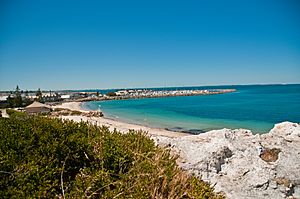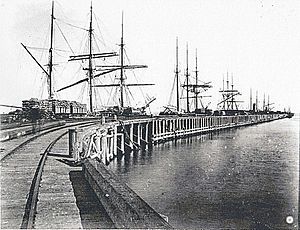Fremantle Long Jetty facts for kids

The Fremantle Long Jetty was a very important pier built in 1873. It replaced an older, smaller jetty called the South Jetty. This was needed because many ships were coming to Western Australia.
The jetty was located in Bather's Bay. This area has been used by people since the Swan River Colony started in 1829. The Long Jetty was a major hub for trade and communication for both Fremantle and Perth. It was used until the Fremantle Harbour opened in 1897.
By the late 1860s, more ships meant better port facilities were needed. Building a full harbour at the mouth of the Swan River was too expensive and difficult at the time. So, the Long Jetty was built as a cheaper solution.
In 1984, plans for a new marina for the 1987 America's Cup sailing race threatened the old jetty's remains. This led to archaeologists from the Western Australian Museum digging up the site to learn more about its history.
Contents
History of the Long Jetty
Construction of the Long Jetty in Fremantle finished in 1873. It took the place of the earlier South Jetty, which was built in 1857.
The Long Jetty was first called the Ocean Jetty. The first part of it was made from jarrah wood. It was built by Mason, Bird and Co., who owned the Canning Saw Mills. The jetty stretched out from Anglesea Point towards the southwest.
From the 1870s to the 1920s, the Long Jetty was a vital maritime centre for the colony of Western Australia. It was the main way for goods and messages to enter and leave the region. This continued until the Fremantle Harbour opened in 1897.
The first part of the jetty was 4.6 metres (15 ft) wide and 230 metres (750 ft) long. It could handle ships weighing up to 700 tons. However, larger ships had to anchor further out. Their cargo was then brought to shore using smaller boats.
The main goods sent out from the colony were wool, wheat, and timber. These were carried by large ships. Since these ships couldn't load directly from the jetty, smaller boats were used to transfer the cargo.
In December 1887, the jetty was made longer, reaching 728 metres (2,387 ft). The original section was also made wider, to 13 metres (42 ft). This allowed six large ships to dock at the same time in deeper water. Because of this addition, the Ocean Jetty became known as the Long Jetty.
In 1896, the jetty was extended one last time, adding another 139 metres (457 ft) into the ocean. This was done because it was still hard to transfer goods from big ships using small boats, a process called "lightering." With a total length of 1,004 metres (3,294 ft), eight large ships could dock at once. But lightering was still often needed.
The jetty was often too shallow for most large ocean ships. Even after being lengthened many times, it never became deep enough. It was always necessary to use smaller boats, called lighters, to help unload cargo from bigger ships. In 1897, over one-third of the 600,000 tons of materials that passed through the Long Jetty needed lightering.
In 1897, the jetty was 1,004 metres (3,294 ft) long. But it only reached a depth of 7 metres (23 ft) at its very end. The two extensions were built by R. O. Law and Mathew Price. R. O. Law was very young when he got the contract in 1887. He was also later given the job of taking down the Fremantle Long Jetty when it became unsafe for people.
In the early 1890s, during the Australian gold rushes, the Long Jetty was extremely busy. Ships were constantly arriving and leaving. Even at its longest, lightering was still needed for many shipments. When Fremantle Harbour opened, it removed the need for lightering. This made the Long Jetty no longer needed for importing and exporting goods.
Exploring the Jetty's Remains
In the late 1960s, people who collected old bottles became interested in the jetty again. The ocean floor around the jetty was covered with old soda and beer bottles. Bottle collectors had visited the site often since it stopped being used. They noticed that storms would uncover new items from under the seabed.
Scuba divers also frequently visited the site for fun or to collect bottles. The site has many holes dug by these collectors. They had taken almost all the interesting items, leaving only broken pieces scattered around.
In 1984, plans for a new marina for the 1987 America's Cup threatened to cover large parts of the Long Jetty's remains. After many years of not being used, the jetty was mostly just a line of wooden piles. Most were barely visible above water. Only one pile stuck out 3 metres (9.8 ft) from the water.
The Western Australian Maritime Museum was given only four weeks' notice to record the site. This was before construction on the new marina would begin. The new marina plans involved covering a large part of the old jetty.
Michael McCarthy from the Maritime Archaeology Department led the archaeological investigations. This was a "salvage archaeology" project. This means they had to quickly save information and artifacts before the site was destroyed. The museum immediately started to figure out how the marina would affect the old jetty.
The goal of the excavation was to map the remaining jetty structure. This would show how much material was spread out. It would also help them understand how much of the jetty might be covered or disturbed by the marina. Archaeologists mapped the jetty piles using special measuring techniques and photography. This helped them create a map of the site.
McCarthy had a small budget of $2,000 for the excavations. Because of this, volunteers from the Maritime Archaeological Association of Western Australia (MAAWA) helped out. MAAWA is a group of volunteers who work to protect and teach people about maritime sites. They were experienced in searching underwater and doing research. Other volunteers from a local high school also helped as part of their work experience.
These MAAWA divers searched the seabed for artifacts. They marked areas with many artifacts using buoys. Museum staff would then investigate these areas further. $1,315 of the $2,000 budget was spent on the digging phase.
Because they had little time, McCarthy used special digging methods. These included "airlift" and "propeller wash" techniques to move sand and dirt. Seventy test holes were dug to explore the site.
Most of the artifacts found were made of glass. They came from Australia or Great Britain. Some glass items were also from the United States of America. All the bottles found were from between 1840 and 1920. Alcohol and soft drink bottles were the most common. But pickle, sauce, and medicine containers were also often found. The most common type of bottle looked like today's champagne bottles.
Artefacts Found
Many artifacts were found during the digs. Most were covered by a protective layer of sand and mud, up to 2 metres (6 ft 7 in) deep. Found items included buttons, buckles, fasteners, rings, toys, pipes, old ammunition, shoes, and fishing gear.
Some of the artifacts were carefully recorded and preserved. They were then put on display for the public. Since the site was close to the Maritime Museum, recovered artifacts were placed in tubs of fresh water. This started a process to remove salt from them. Fragile artifacts were wrapped in soft nylon mesh to protect them during the short trip to the Museum.
Exhibition and Protection
Soon after the digging finished, the Western Australian Maritime Museum opened an exhibition about the Long Jetty. This was to teach the public about its history. The attention from the excavations, public education, and news articles helped. It led to changes in the marina wall's design. The new design would now avoid the jetty piles, protecting the remains of the Long Jetty from being destroyed. However, a small part of the jetty would still be affected.
The Jetty Today
The Long Jetty is an important link to the past. It is a valuable historical resource that helps us understand how Fremantle city grew economically and socially. The site is also important because of its connection to people moving to Western Australia.
Artist Joan Campbell created ceramic plaques. These plaques show the museum's work and the history of the Fremantle Long Jetty. They were placed at the beach end of the structure. The area is now used for fun activities by the public. You can still see parts of the Long Jetty today. About 30 of the original wooden piles stick out from the water's surface.
Protecting the Site
In 1988, the seabed around the part of the jetty built before 1900 was made a historic site. This was required by the Maritime Archaeology Act of 1973. This law says that all seabed areas under jetties in Western Australia used before 1900 must be protected as maritime archaeological sites. This means the Act covers almost all the area where the Long Jetty once stood.
Images for kids



